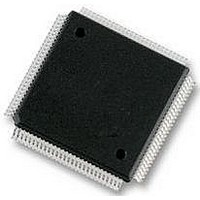XC68HC12A0CPV8 Freescale Semiconductor, XC68HC12A0CPV8 Datasheet - Page 46

XC68HC12A0CPV8
Manufacturer Part Number
XC68HC12A0CPV8
Description
IC, 16BIT MCU, 68HC12, 8MHZ, TQFP-112
Manufacturer
Freescale Semiconductor
Datasheet
1.MC912D60ACFUE8.pdf
(460 pages)
Specifications of XC68HC12A0CPV8
Controller Family/series
68HC12
No. Of I/o's
68
Eeprom Memory Size
1KB
Ram Memory Size
2KB
Cpu Speed
8MHz
No. Of Timers
1
Core Size
16 Bit
Program Memory Size
60KB
Peripherals
ADC
Lead Free Status / RoHS Status
Lead free / RoHS Compliant
- Current page: 46 of 460
- Download datasheet (5Mb)
Pinout and Signal Descriptions
Technical Data
46
output to indicate that an internal failure has been detected in either the
clock monitor or COP watchdog circuit. The MCU goes into reset
asynchronously and comes out of reset synchronously. This allows the
part to reach a proper reset state even if the clocks have failed, while
allowing synchronized operation when starting out of reset.
It is important to use an external low-voltage reset circuit (such as
MC34064 or MC34164) to prevent corruption of RAM or EEPROM due
to power transitions.
The reset sequence is initiated by any of the following events:
External circuitry connected to the reset pin should not include a large
capacitance that would interfere with the ability of this signal to rise to a
valid logic one within nine bus cycles after the low drive is released.
Upon detection of any reset, an internal circuit drives the reset pin low
and a clocked reset sequence controls when the MCU can begin normal
processing. In the case of POR or a clock monitor error, a 4096 cycle
oscillator startup delay is imposed before the reset recovery sequence
starts (reset is driven low throughout this 4096 cycle delay). The internal
reset recovery sequence then drives reset low for 16 to 17 cycles and
releases the drive to allow reset to rise. Nine cycles later this circuit
samples the reset pin to see if it has risen to a logic one level. If reset is
low at this point, the reset is assumed to be coming from an external
request and the internally latched states of the COP timeout and clock
monitor failure are cleared so the normal reset vector ($FFFE:FFFF) is
taken when reset is finally released. If reset is high after this nine cycle
delay, the reset source is tentatively assumed to be either a COP failure
or a clock monitor fail. If the internally latched state of the clock monitor
fail circuit is true, processing begins by fetching the clock monitor vector
($FFFC:FFFD). If no clock monitor failure is indicated, and the latched
state of the COP timeout is true, processing begins by fetching the COP
•
•
•
•
Power-on-reset (POR)
COP watchdog enabled and watchdog timer times out
Clock monitor enabled and Clock monitor detects slow or stopped
clock
User applies a low level to the reset pin
Pinout and Signal Descriptions
MC68HC912D60A — Rev. 3.1
Freescale Semiconductor
Related parts for XC68HC12A0CPV8
Image
Part Number
Description
Manufacturer
Datasheet
Request
R
Part Number:
Description:
Manufacturer:
Freescale Semiconductor, Inc
Datasheet:
Part Number:
Description:
Manufacturer:
Freescale Semiconductor, Inc
Datasheet:
Part Number:
Description:
Manufacturer:
Freescale Semiconductor, Inc
Datasheet:
Part Number:
Description:
Manufacturer:
Freescale Semiconductor, Inc
Datasheet:
Part Number:
Description:
Manufacturer:
Freescale Semiconductor, Inc
Datasheet:
Part Number:
Description:
Manufacturer:
Freescale Semiconductor, Inc
Datasheet:
Part Number:
Description:
Manufacturer:
Freescale Semiconductor, Inc
Datasheet:
Part Number:
Description:
Manufacturer:
Freescale Semiconductor, Inc
Datasheet:
Part Number:
Description:
Manufacturer:
Freescale Semiconductor, Inc
Datasheet:
Part Number:
Description:
Manufacturer:
Freescale Semiconductor, Inc
Datasheet:
Part Number:
Description:
Manufacturer:
Freescale Semiconductor, Inc
Datasheet:
Part Number:
Description:
Manufacturer:
Freescale Semiconductor, Inc
Datasheet:
Part Number:
Description:
Manufacturer:
Freescale Semiconductor, Inc
Datasheet:
Part Number:
Description:
Manufacturer:
Freescale Semiconductor, Inc
Datasheet:
Part Number:
Description:
Manufacturer:
Freescale Semiconductor, Inc
Datasheet:










